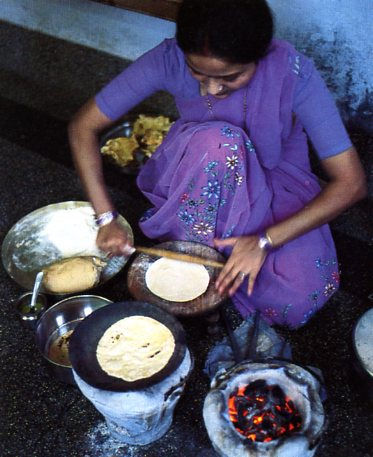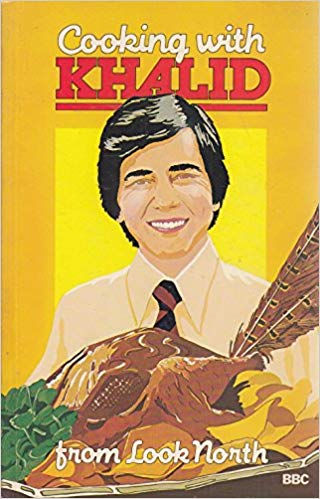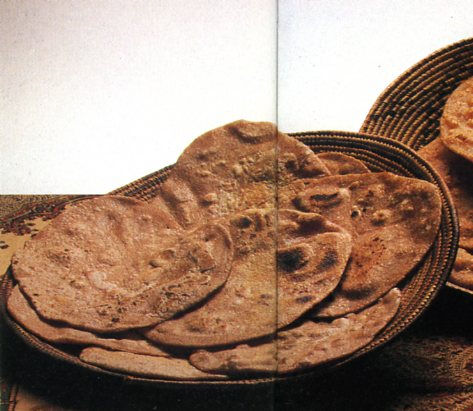Chapattis - a first recipe
- rosemarydearman1
- Nov 16, 2019
- 7 min read

"The secret to good chapattis is to cook them and eat them within the space of half an hour. Any longer delay and they tend to become very tough. As you can imagine, this means that the person doing the cooking gets little time to sit down to enjoy the food with everyone else, but as long as the chapattis are put into a warm tea towel in a basket as soon as they are cooked and kept covered to prevent the moisture disappearing, they will keep reasonably well." Khalid Aziz

This is the introduction to a recipe for chapattis - the very first recipe in one of my Indian cooking books. One of the first I had from the time before I discovered Madhur Jaffrey, but, I think, a little after Charmaine Solomon. It is actually a pretty good book and I should use it more often. The photographs of the food are pretty good, but a little dated I suppose, but each chapter is introduced with a full page reproduction from some of those exquisite paintings from the Mogul era. Chapter one, from which the recipe for chapattis (and other breads) comes, is a chapter on accompaniments and includes a variety of chutneys and pickles. The painting shows a variety of cooking activities surrounding the meal being served to the important person in the centre of the picture. There's a lot going on here, and I'm not sure whether any of the little pieces that make up the whole, show the making of chapattis, but I also found on the net a sketch for a painting dated 1775 of people preparing them.

I suspect that little has changed in more modest Indian and Pakistani homes, as Madhur Jaffrey had this picture of chapattis being prepared in one of her books.

But before I go on to tell you how to cook chapattis here is a little bit more about the book and its author. The book is called The Encyclopaedia of Indian Cooking and is by one Khalid Aziz. Not An Encyclopedia - but The Encyclopedia, which is a fairly big claim. And yet it's not that thick a book - 191 pages in about an A4 size. Also, interestingly it arranges the chapters by regions, although not all regions are covered. For example there are three chapters on vegetable dishes - for eastern, southern and northern, leaving one to wonder whether they eat vegetables in the west. And fish is confined to Bengal and Kerala. Well we probably all know that these are the most famous areas for fish, but there is no doubt that fish is eaten everywhere. So it's more of a selection than a comprehensive Encyclopedia. But I am being a bit picky here, because it is a lovely book and most of the dishes we know and love are covered, plus a few more but omitting the pseudo Indian dishes like balti dishes and chicken butter cream.

My copy of the book alas - shown here on the left - was partially eaten by our first two dogs when they were puppies. It was - and still is - on the bottom shelf - well the shelf is the floor actually - and is at the end of the shelf. (This is the last of my first recipe books from my first shelf). I think we must have gone out, leaving the dogs shut into the kitchen area, and when we returned I found that it had been chewed away at the top. The book itself is only slightly damaged, it's just the cover really, but it was a bit sad.
The author as I said is one Khalid Aziz who seems to have written a couple of other books on Indian food. He must be an interesting guy because this is what I eventually found out about him.

As a young man, he worked as a presenter and journalist on television, initially for the BBC and then for ITV. I think he must have perhaps done some cooking on the television too, as one of his books has 'from Look North' as its subtitle with Look North being the name of the program that he presented on the BBC. I believe he was one of the youngest presenters on the TV of the time too. He also produced programs and then documentaries after he left ITV.

Then I found that there was a Khalid Aziz who is now a successful businessman - a corporate coach in all manner of business skills, but particularly communication. He is also a visiting professor at Southampton and Winchester and has received various journalistic, business and general honours. An accomplished and highly respected man.
These two people looked sort of alike, but neither of the profiles I read mentioned writing cookery books, although the profile of the businessman did talk about the career as a TV presenter, so indeed they are both the same man. The only question was did he write the books. The book 'from Look North' was pretty convincing, but the final clincher was the brief biography on the back flap of my book which said that he is:
"well known as a cookery writer and television presenter. Born in Lahore, he has spent his life immersed in the cooking traditions of India and he has also been involved in his family's two Indian restaurants in London."
So a kind of split personality, with the two very public parts of his life - TV presenter, and businessman, denying his other career and his family restaurants, and, according to the publishers, his great interest in and knowledge of Indian cooking. And he's Pakistani too, not Indian. But then lots of owners of Indian restaurants are apparently Pakistani. Which is a whole other topic really. What's wrong with Pakistani cooking? Why don't we have books on Pakistani food? Is it different? Anyway all very interesting. The book, by the way, was published in 1983 when he had just left ITV and was producing documentaries, whilst simultaneously starting his corporate coaching business.
But back to chapattis. Here we are again, talking about flour and water and what you can do with it. There's no yeast here either. This is bread at its most basic. The name chapatti comes from a Hindi word 'chapat' which means 'to slap' which is what you do with the rolled out breads. You slap them on a tava - a slightly curved heated iron plate - which you can see in Madhur Jaffrey's photo above. They really are the only kind of flatbread that I make on a reasonably regular basis. Sometimes they puff up for me, sometimes they don't. It might be something to do with how long I leave the dough to rest before cooking, how long I knead it, the temperature of my cast iron pan that I cook them in. I really don't know.
Many people suggest that you hold them over the open gas flame with tongs, and that this will make them puff up. Maybe I should try that.

The recipe I use is from my very first Indian cookbook - Cooking the Indian Way, which I have spoken about before - and that recipe includes a little oil in the mix. But otherwise it's just wholemeal flour and water. Wikipedia suggests that the wholemeal flour that the Indians use is finer than ours, but I suspect this does not really matter. Aziz says that you mix to a hard dough, knead for 5 minutes until smooth and elastic and then rest in the fridge for 3 hours. Now I did see somebody else say that you only needed to rest it for 15 minutes, and I confess that I often don't rest it at all because I'm not very good at planning in advance. Maybe this is why it doesn't puff up - it was certainly suggested somewhere that resting it makes it puff up.
After resting you tear off small balls and roll them out into small circles. Then - I am going to give you the instructions from this book - that include the over the flame bit.
"Sprinkle a little flour into the frying pan, heat it and place the chapatti in it. Cook until it is dry on one side, turn it over and cook the other side. This should take about a minute. Once you have done this, remove the frying pan from the heat and using tongs place the cooked chapatti directly onto a low heat source. If this is gas you should leave it there for a couple of seconds and then flick it over onto the other side. It takes slightly longer on electric cookers. You will see that brown spots begin to form on either side and the chapatti should puff up almost into a sphere. Place the chapatti in a tea towel and wrap, keeping warm in a low oven before serving."
So maybe I've been doing it wrong all along. My 'old' recipe doesn't mention holding it over a flame at all. Maybe next time I'll try this out.
You use them any way you use other flatbreads - mostly to sop up sauce - we use them to accompany tandoori chicken (well my version thereof). My son rolls his up in the chapatti, I just use them to sop up the sauce. As I hinted, my version is not very authentic and I end up with sauce, which you would not have if I had a tandoori oven. I sometimes mix some chopped herbs in with the flour too. And I sometimes have a mix of wholemeal and white flour which probably makes them lighter. And yes they are a bit chewy, but chewy is nice.
Sometimes they are simply served with chutneys and pickles - a bit like pappadums, and the Indians often spread them with butter. Well we spread butter on bread don't we, so why not? You could make up an interesting kind of mezzo/antipasti this way.

Incidentally, later in the chapter he suggest that a way of using up old, tough chapattis is to spread with jam and cream, roll up, chill in the refrigerator and then eat. But bearing in mind that he said they toughen up, I'm not sure I'm convinced by this. I guess if you could split them you could roll them round some kind of stuffing and then cook them in the oven with a sauce.
Well that's the end of my first shelf of cookbooks. These were all tall books - it's a tall shelf. The next shelf is smaller.
This is the photograph from the book - not particularly tempting looking are they? The ones from Taste.com at the top of the page look rather more delicious.













Comments